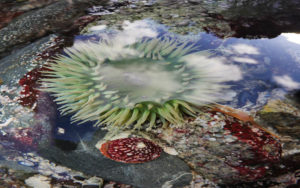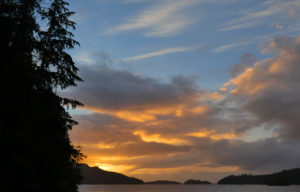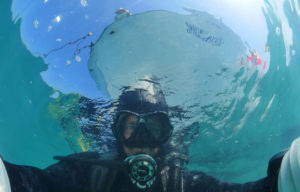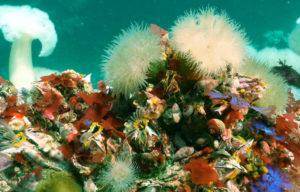Diving
Barkley Sound
World-class cold-water diving
Barkley Sound looks like a big bite taken out of the West Coast of Vancouver Island. In a triangle it is enclosed by Bamfield in the south, Ucluelet to the west and Port Alberni to the north. The Broken Islands group in the west are part of the Pacific Rim National Park. Coming from Port Alberni and going south, you descend the Alberni inlet to where it meets Barkley Sound and a maze of islands offers stunning landscapes.
Here is a short aerial view of the area.
Barkley Sound has some of BC’s very best diving so don’t deprive yourself of a great dive trip!
Walls
Pinnacles
Reefs

Diving Barkley Sound
What to expect…
Ecology

Barkley Sound offers a unique richness in both plants and animals. Underwater you will find a rich diversity of fish, invertebrates, marine mammals and kelp forests. Salmon, rock-fish, herring, squid, giant octopus, sea otters, seals, and sea lions are all permanent residents. Others like orca, grey- and humpback whales, Puget Sound King crab, sea pens, and six gill sharks add flavor to your dives and make your stay unforgettable. In the majestic forests you may find everything from beavers and otters, to bears, cougars, eagles and many more species. They form integrated eco-systems with the life in the water.
Climate

With the British Columbia climate, a lush and ever green landscape has developed. Although certain spots on the island get a lot of rain, it can be said that the climate is mild. In summertime it can be as warm a 35° C (103° F) but there is always a nice cooling breeze. Due to the ocean’s influence, it never gets very cold, but in the winter there can still be snow and temperatures can drop to -10°C (12°F). Luckily, the islands, coves and inlets of the Sound provide good protection against winter storms and allow year round diving.
Diving Conditions

The water temperatures vary between 8-10°C (48-50°F) in the winter, to around 19° C (70°F) in the summer in the top 20 meter (66 ft) layer. Visibility is best in winter with 30+ meters (100 ft+). In June the algae blooms may reduce the visibility to a mere 10 meters (30 ft) in the top layer, but most of the time the visibility stays good once you are deeper than 12 meters (40 ft). The abundance of life is year round and the kelp forests can best be seen in the summer or autumn.
Dive Sites

It would be impossible to describe all of our dive sites, but to give you an idea of what you can expect, we give you a general description of the most frequented sites. Remember that a dive site may yield very different experiences depending on time of year, weather and luck.
Kyen point: consists of 2 pinnacles, separated by a sand channel. Wolf eel and octopus are among the permanent residents and occasionally sea lions or seals hang around. A large wall of strawberry anemones makes an astonishing home for a wide variety of invertebrates.
Renate Reef: lots of invertebrate life as well as a wealth of fish. This pinnacle with its large flat top is home to giant octopus, wolf eel, lingcod, strawberry anemone’s, ratfish, rockfish and many other colorful creatures.
Chup point: A heaven for the macro photographer. Scores of small and larger invertebrate life color this shallow reef. Its depth allows for longer bottom time and more natural light for your photos. Nudibranches, sea pens, anemones, scallops, purple ring top snail, doris, orange peels are commonplace on this site.
Plan your trip to Rendezvous Dive Adventures
Book your stay !
Check our calendar for availability and contact us for your best trip experience
We speak your language:
English, Français, Nederlands, Deutsch - and Scuba!
Rendezvous Dive Adventures Ltd. , PO BOX 425, Port Alberni, BC V9Y7M9